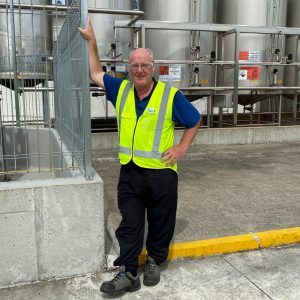Cheesemaking at Fonterra’s Edendale site in Southland celebrates 150 years this month. By Karen Trebilcock.
After celebrating 150 years of New Zealand’s first dairy co-operative in spring last year, Fonterra has another milestone this month.
On January 18, 1882, 140 years ago, the first batch of cheese was produced and placed on the press at 3pm at the Edendale dairy factory.
The milk for the cheese came from the factory’s own herd of 300 cows.
Sheep had proved unprofitable on the new pastures at Edendale owned by the New Zealand and Australian Land Company so in 1881, the company’s superintendent, Thomas Brydone from Scotland, thought dairying would be better.
Brydone made sure lime and fertiliser was added to the young grasses and they soon flourished. The Edendale Dairy Factory Company Ltd was born.
The same year, 1882, the SS Dunedin began sailing to England loaded with refrigerated mutton and lamb. Brydone made sure Edendale butter and cheese was onboard too.
By the early 1900s, Edendale was processing 3000 litres of milk and, in 1920, milk pasteurisation was added, a first for the country.
Its cheese was sold under the Pioneer label.
In 1914 all the whey from Edendale was processed into lactose milk sugar (1387 lbs), a first for the Southern Hemisphere, and sold under the brand name Wyndale.
Lactose is still produced under the Wyndale brand at Fonterra Kapuni in Taranaki.
A contractor’s tip truck was fitted with a removable 7000 litre tank in 1958 and became Edendale’s first milk collection tanker for farm pickups. Before this, farmers delivered their own milk to the plant.
In 1987, the first of what are now three Anhydrous Milk Fat (AMF) plants was commissioned (0.5 t/hr) to process whey cream and the first night collection of milk started.
In 1994, Drier 1 commenced production, processing 900 cubic metres/day of Whole Milk Powder (WMP) and Skim Milk Powder (SMP).
Drier 2 powder plant was commissioned in 2002 (2500 cu m/day WMP and SMP), Drier 3 the following year (2500 cu m/day, WMP and SMP, 11 M litre site capacity) and in 2009 Drier 4 (4000 cu m/day WMP 15 M litre site capacity) making Edendale the largest raw milk processing site in the world at the time.
Edendale’s 2015 expansion project involved building four new plants on site – a milk protein concentrate plant, a reverse osmosis plant, a milk treatment plant, and an anhydrous milk fat plant. It now has 13 plants making it one of Fonterra’s largest processing sites.

From cheese hand to boss
For David Thwaites, Edendale Cheese Plant manager, good things do take time just like in the TV ad.

But it’s not the cheese he’s talking about, because at Edendale they can turn liquid milk into a 20kg block of cheddar in about five and a half hours.
Instead, he’s talking about his career.
He started at the Edendale factory from his family’s Southland sheep and beef farm at 18, in September 1975, as a cheese hand and is now the plant’s longest serving employee.
Of the 140 years of history of the plant, he’s been there for a third of them.
“I was due to finish up school and I didn’t know what I wanted to do next. I got offered the job at Edendale, my dad knew the plant manager, and I started the very next day.
“It was daunting at first, with all of the white lab coats, boots and hats and you had to be fit with all of the manual handling.
“Some people didn’t last their first day. We worked seven days on and one day off and our wages were split between us so when we were short staffed we made a lot of money. One year I worked three months without a day off.
“In those days you worked hard and then you played hard. There were plenty of events – we were one big family and you just enjoyed each other’s company.
“It was a lot of fun, making cheese, there was also a cheese bar on site, so you got to see locals loving the product as well.”
When he started, the changeover was happening from farmers bringing their own milk to the factory to milk tankers only.
From a cheese hand, he worked at CIP (clean in place), then as a pasteuriser, a starter, a salter operator, supervisor and finally, for the past 25 years in management.
Although Pioneer branded cheese from Edendale could be bought in New Zealand until about 15 years ago, now all of the cheese produced at the site is sold on the Global Dairy Auction.
“We’re a peak milk plant so we run from September until the start of December each year and all of the product is exported. It can go anywhere in the world.”
A 12-hour shift produces 47,000kg of cheese.
“It hasn’t really changed since 1882. It’s still the same cheese, made the same way. It’s just more automated now and we make a more consistent product.
“The cheddar is made using microbial rennet starter cultures which comes from Fonterra Palmerston North, and then it’s pH controlled through the process and salt is added.”
Mild cheddar is about two months old, tasty is six to nine months and veteran is nine months to a year and a half.
“It’s all about the temperature as well. We keep our cheese at 4C but if it’s at say 10C it ages a lot faster.”
David says the great taste of Edendale cheese comes from Southland’s cows and the grass they eat and he’s a fan of veteran cheddar – “something with a bit of bite”.
“The milk from our cows down here brings out the best flavour. It’s a very exportable cheese. We have a wall of awards from New Zealand and Australia, and from all over the world including Europe.
“It’s something we’re very proud of.”





